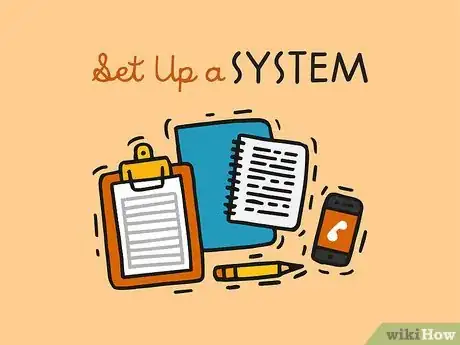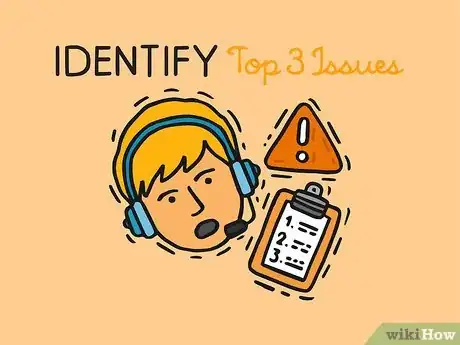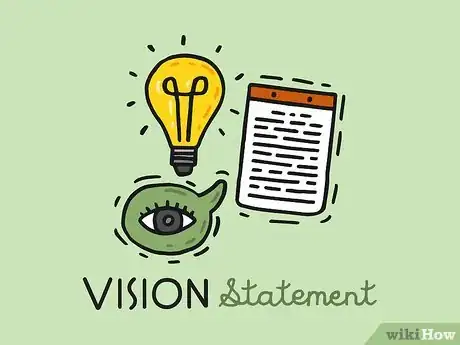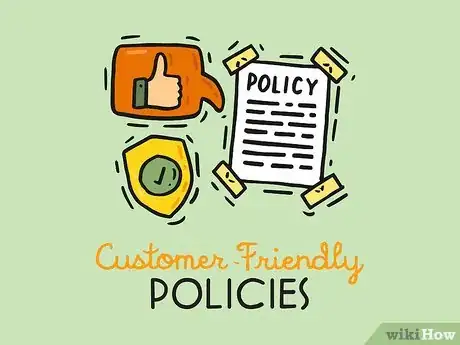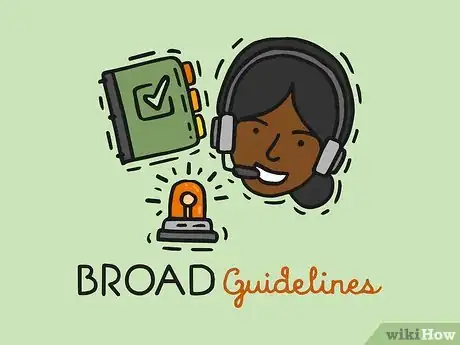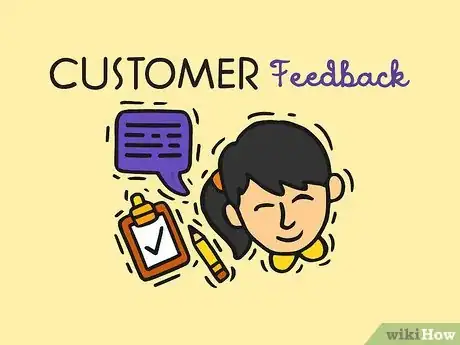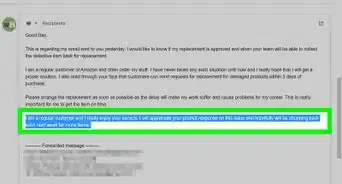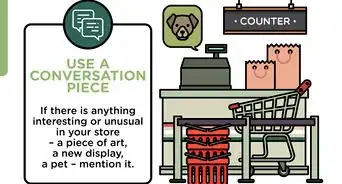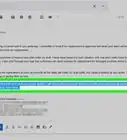This article was co-authored by Linda Chau. Linda Chau is a Public Relations Specialist and the CEO and Founder of PAAPR Agency (Public Attention And Public Relations). With over a decade of experience, she specializes in strategic planning, brand storytelling, press communication, and reputation management. Linda holds a BA from The University of California, Riverside and has been featured in AdAge, Austin Business Journal, and more.
There are 8 references cited in this article, which can be found at the bottom of the page.
This article has been viewed 241,932 times.
With more ways to contact businesses than ever before – phone, websites, email, social media, in person – customers expect more and more responsive companies. Quality of service has gone from a competitive advantage to a necessity.[1] Research shows that over two-thirds of customers who stop using businesses do so because they find the service staff unhelpful, while 55% would pay more to guarantee good service[2] [3] In order to improve the service of your company, or to establish that your new venture is customer oriented, you will need to evaluate your current service, investigate your customer’s needs, and develop a flexible customer service policy that addresses those needs.
Steps
Learning More about Your Customers’ Needs
-
1Set up a system to document customer complaints and comments. Your customer service policy should be tailored to the needs of your customers, and if you listen, your customers will tell you what those needs are. If you don’t have a systematic way to compile this information, develop one. The information recorded should include:[4]
- The customer’s name, address, and phone number
- The name of the employee receiving the complaint
- The date and time of the complaint and of its resolution
- The nature of the complaint
- The agreed upon solution, whether it was implemented on the spot, and if not when it was promised
- What steps are currently being taken
- The date and time of follow up to ensure the customer is satisfied
- Any compensation given to the customer
- Suggestions on how the problem can be avoided in the future
-
2Create surveys and run focus groups. In both cases, your goal should be to gather useful information rather than positive feedback. To do so:[5]
- Ask open-ended questions that lend themselves towards specific feedback, rather than focusing on rankings, which tell you little about how to address them. Ratings are less important than why you are getting those ratings.
- Use professional firms or online survey sites to help develop questions that are truly objective and don’t stack the deck to get you favorable results. What you need is useful feedback, not praise.
- Use online surveys to gather information in real time. You need to know what your customers need today, not two months ago. The best way to do this is to use a self-serve or full-service online system to gather customer feedback.
Advertisement -
3Consult your employees and operational data. Organize focus groups to talk to your employees about frequent customer issues they deal with. Also look at stats like the number of returns and return rate to determine how happy customers are with your products. Other stats to consult include:[6]
- The status of backlogs and stockouts – If your products are unavailable, you can bet your customers are less than satisfied.
- Internal reject rate – If the rate is high, then there is a good chance some bad products are reaching customers. Bad products mean dissatisfied customers, and the typical dissatisfied customer tell 9-15 people about their experience.[7]
-
4Talk to your vendors and service providers. If you outsource various aspects of your business like shipping or website management, these service providers may have valuable information about your customers.[8]
- Ask your website administrator to categorize types of feedback and transmit it to you.
- Ask your shipping unit how frequently it must re-do orders that are rejected the first time they ship due to defects or other problems.
- Ask your customer service call-center to categorize complaints and other feedback and transmit it to you. Also ask about typical customer wait time and how many customers call and hang up before reaching a service agent.
-
5Identify your top three significant customer service issues. Combine internal and vendor input and compare it to information from your customers in order to create a list of problems. Focus on ones that come up frequently, affect your bottom line, and are actionable (i.e. “my order was defective” rather than “I was dissatisfied”).[9]
Creating your Customer Service Policy
-
1Develop a vision statement. This is the guiding principle that informs how your company seeks to interact with its customers. It is both a daily reminder and a goal to be aspired to. It should be simple and dirc’s vision for McDonald’s: “Quality, Service, Cleanliness, Value.” To come up with your vision statement:[10]
- Looking 3 to 5 years into the future, imagine your company’s success and list five reasons for it.
- Now list the reasons for your success from the customer’s viewpoint.
- From the vantage point of this future success, list the steps you have taken to upgrade customer service.
- Based on these lists, summarize the key elements of your vision.
- List the verbs from you summary and use them to build a concise vision statement.
-
2Set customer service goals in line with your vision and based on your research into customer needs. These goals should provide quantifiable targets to address the customer service areas you identified as most important. For example:[11]
- A time limit by which all calls to the service center be answered
- A target for the percentage of products returned
- A target for the percentage of customers who report that they are satisfied with how their complaint was handled
- A target for the percentage of customers who complain who go on to purchase your service or products again
-
3Make your customer policies straightforward and customer-friendly. Review your customer feedback to see which policies have proven most troublesome. If possible, get rid of them. Be sure to consult your employees to get their feedback on any proposed policies. They will often have a better feel for how the customer interacts with the customer service policy.
- You can find examples of straightforward, succinct customer service plans at thethrivingsmallbusiness.com and aa.com (American Airlines).
-
4Use your goals as a guide in creating your customer service policy. Once you have hashed out a policy, take time to consider it from the customers’ point of view. Policy areas to touch on include:[12]
- Product or service overview – Do you have policies in place to make it as easy as possible for customers to learn about what you sell?
- Speed – Can your customers order quickly and painlessly? Are knowledgeable customer service representatives readily available? Consider setting a maximum wait time for in store and phone service, and then consider what it will take to achieve those service standards.
- Communication – Do you do a good job of informing customers of everything they need to know to do business with you? Return and shipping policies should be easy to locate. Accepted forms of payment should be clearly displayed. Add-on services and warranties should be explained without pressure to buy.
- Follow up – Your customers should be given the name, phone number, and email of a person to contact if they need help after a purchase. Show them a timeline for service or product delivery. Give information on how to seek technical support or other help. Make it easy for them to complain if they need to do so.
- Complaints – Are complaints handled promptly? Are employees given the freedom to problem solve to reach the best solution? Is higher level management involved quickly? How are customers compensated for various problems? Is there follow-up to ensure customer satisfaction?[13]
- Retention – Are you building long-term relationships with your customers? Contact them a month after the transaction to be sure they are satisfied. Consider sending out a newsletter or coupons to customers. Create customer forums on your website.
- Employee monitoring – Are you encouraging your employees to provide good customer service? Do you share customer feedback with them and confront them when they are not meeting service standards? Do you recognize and reward them when they provide good service?[14]
-
5Give your employees discretion to deal with customer problems. What you don’t want are policies that are used as weapons against the customer – e.g. “I’m sorry I can’t do more, but it’s company policy” – or problems that drag on and frustrate customers. Instead of strict rules, give your employees broad guidelines to help them problem solve:[15]
- Understand the problem – Let the customer speak without interrupting, note the important facts, and repeat them to be sure you got it right. “Just to confirm, you want to receive a new unit and get a refund, right?”
- Identify the cause – Find out what the customer did, review what should have happened, and isolate the problem. Identifying the cause often means accepting that the company, not the customer, is responsible for the problem. “You ordered a unit that our website says works with your system. You should have been able to plug it in and use it, but the literature on the website must be mistaken, because the unit is not compatible with your system.”
- Propose solutions – First ask the customer for ideas. If he or she has a clear idea of how they want the situation resolved, either agree or work with them to finalize a plan that works for the customer and the company.
- Solve the problem – Take corrective action and ask the customer if they are pleased with the way the problem was resolved. Apologize for the trouble and ideally, offer the customer something as compensation for their trouble.
-
6Train your employees in the new policy. Hold a mandatory meeting to introduce the plan and to explain its purpose. Afterwards, work training into regular meetings, as well as holding training workshops to teach your personnel particular skills such as problem solving for complaints.[16]
Evaluating Your Current Service
-
1Set a baseline to see how responsive your current customer service program is. If you are developing a customer service policy, chances are you are either starting a new business or worried about your current service. If it’s the latter, you’ll need to start by assessing where your current service is weak. To determine you “customer service quotient," rate your business on a scale of 1 (not at all) to 5 (all the time) for each of the following statements, adapted from the Forum Corporation’s Self-Test for a Customer-Driven Company:[17]
-
2Consider how customer-oriented your company’s culture is. Do you put the customer first, or are you more concerned with your own internal affairs? Rank your business on the following to find out:
- We’re committed to do whatever it takes to create satisfied customers.
- We try to do things right the first time.
- As the owner, I set an example that customer service is important.
- Serving our customer’s needs takes priority over our internal needs.
- Total your score and divide by 4.
-
3Ask yourself how well your products and sales materials are oriented towards customers. If you think a good product will sell itself, you’re wrong. You need to tailor your products to your customers’ desires. Rate the following:
- When we sell, we aim for a partnership approach.
- In our advertising materials, we don’t promise what we can’t deliver.
- We know the features and benefits that matter most to our customers.
- We design new products/services based on information provided by our customers.
- Total your score and divide by 4.
-
4Rate how well you respond to customer feedback. Especially if you are in a service industry, it is vitally important that your customers feel they are being heard and their complaints addressed promptly. Their feedback is free and extremely valuable, so don’t ignore it. Rate the following:
- We review customer complaints.
- We constantly ask our customers for feedback.
- We regularly look for ways to eliminate errors based on customer input.
- Total your score and divide by 3.
-
5Consider how well your company and employees know your customers. The better you know them, the better you can tailor your service to their needs. Rate the following:
- We've determined what our customers expect from us.
- We frequently interact with our customers.
- All employees know what's important to our customers.
- Total your score and divide by 3.
-
6Know how easy it is for customers to get in touch with your company. On average, for every customer that complains, there are 26 that remain silent. The harder it is to get a hold of you, the worse that ratio will be, which is worrying when you consider that 91% of unhappy customers will leave with no complaint and never come back.[18] Making it easier for them to complain can save you customers. How well do you do each of the following:
- We make it easy for our customers to deal with us.
- We aim to resolve all customer complaints.
- We encourage "wowing the customer."
- Total your score and divide by 3.
-
7Evaluate how qualified your staff is. Your staff is the interface between you and your customers. The better trained they are, the better service they can offer. Rate the following:
- I respect my employees.
- All employees firmly understand our product/service.
- All employees possess the right tools and skills to perform their jobs well.
- All employees are encouraged to resolve customer issues.
- All employees feel that customer satisfaction is part of their job.
- Total your score and divide by 5.
-
8Think about how actively you seek to improve your products. The final part of customer service is constantly seeking to produce a better product that meets or even anticipates consumer needs. Rate the following:
- We constantly work to improve our processes and products.
- We network with other groups to learn from their strengths and weaknesses.
- When we uncover problems, we try to resolve them quickly.
- Total your score and divide by 3.
-
9Add up your scores. The possible scores range from 7 at the low end to 35 at the high end. Focus both on your total score, and on the particular areas where you need to improve.
- 28 and up – These scores indicate your customer service is an asset. You have responsive service tailored to your customers’ needs. Focus on particular areas for improvement.
- 21-27 – Your customer service is adequate, but needs overall improvement.
- 20 or lower – You are likely losing customers due to poor customer service.
Community Q&A
-
QuestionWhat are the uses of customer service policies?
 Community AnswerA customer service policy is a written document that employees follow when dealing with customers who are not satisfied with company's products or services. It also lists that how employees should behave so as to improve the overall experience for customers.
Community AnswerA customer service policy is a written document that employees follow when dealing with customers who are not satisfied with company's products or services. It also lists that how employees should behave so as to improve the overall experience for customers. -
QuestionWhat are some samples of customer service policies?
 Community Answer1) Service extension policy; 2) Collection policy; 3) Cutoff policy; 4) Implementation, Enforcement and amendments to the customer service policy.
Community Answer1) Service extension policy; 2) Collection policy; 3) Cutoff policy; 4) Implementation, Enforcement and amendments to the customer service policy.
References
- ↑ http://srdc.msstate.edu/trainings/presentations_archive/2003/2003_bst_cunningham.pdf
- ↑ https://hbr.org/1991/09/the-service-driven-service-company/ar/1
- ↑ https://www.linkedin.com/pulse/20130604134550-284615-15-statistics-that-should-change-the-business-world-but-haven-t
- ↑ http://www.patsula.com/books/gb51.pdf
- ↑ http://www.huffingtonpost.com/2012/02/27/customer-surveys-5-things-you-need-to-know_n_1263811.html
- ↑ http://edwardlowe.org/digital-library/how-to-create-a-customer-service-plan/
- ↑ https://www.linkedin.com/pulse/20130604134550-284615-15-statistics-that-should-change-the-business-world-but-haven-t
- ↑ http://edwardlowe.org/digital-library/how-to-create-a-customer-service-plan/
- ↑ http://edwardlowe.org/digital-library/how-to-create-a-customer-service-plan/
- ↑ http://edwardlowe.org/digital-library/how-to-create-a-customer-service-plan/
- ↑ http://thethrivingsmallbusiness.com/7-steps-to-creating-a-customer-service-strategy/
- ↑ http://edwardlowe.org/digital-library/how-to-create-a-customer-service-plan/
- ↑ http://www.patsula.com/books/gb51.pdf
- ↑ http://thethrivingsmallbusiness.com/7-steps-to-creating-a-customer-service-strategy/
- ↑ http://edwardlowe.org/digital-library/how-to-create-a-customer-service-plan/
- ↑ http://edwardlowe.org/digital-library/how-to-create-a-customer-service-plan/
- ↑ http://srdc.msstate.edu/trainings/presentations_archive/2003/2003_bst_cunningham.pdf
- ↑ https://www.linkedin.com/pulse/20130604134550-284615-15-statistics-that-should-change-the-business-world-but-haven-t
About This Article
To develop a customer service policy, you first need to figure out the needs of your customers by setting up a system of customer complaints and comments, sending out surveys, or asking your employees about common customer issues. Once you’ve gathered that information, set some goals that address those needs. For example, you can set a time limit for when all service center calls should be answered. Then, using those goals as a guide, you can create a customer service policy that outlines what's expected of your employees in terms of speed, communication, follow up, and complaints. For more information, including how to evaluate your current customer service, read more!
